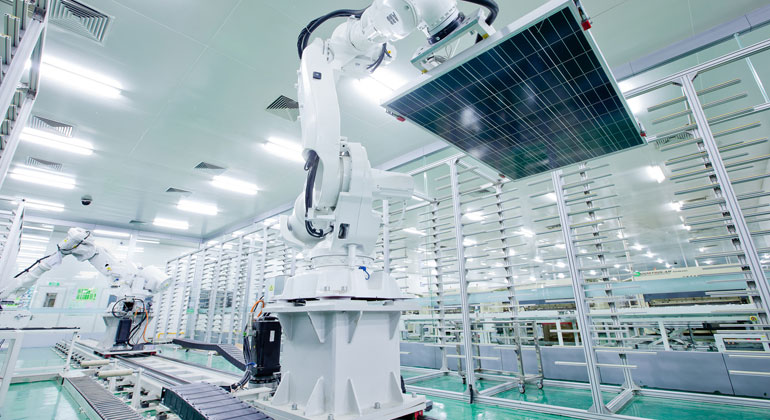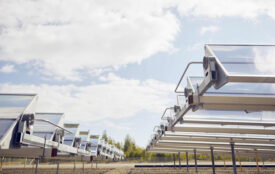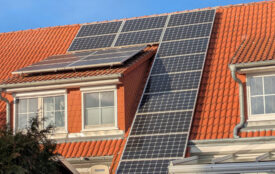Major PV manufacturers foresee a new solar module standard
182-millimeter module will be the mainstream choice thanks to the advantages in low power loss, better compatibility, cost optimization scheme and better reliability.
As we enter into the era of comprehensive photovoltaics parity, the main concern for the PV industry becomes minimizing the LCOE. To some extent, improving the power generation by increasing the size of PV module has become a sort of consensus in PV industry. How can standardized large-size modules reduce the cost of the whole industrial supply chain in the development process of grid parity or grid at a low price? Recently, JinkoSolar, Longi and JA Solar jointly held the conference “Customer Value Focused – Advanced PV Technology for Better LCOE” and had an in-depth discussion with industry experts and industrial supply chain partners. An internal agreement has been reached in the conference that 182mm modules will achieve more marketing opportunities.
The High Reliability of JinkoSolar 182mm Modules
Through a large number of reliability tests, 182mm modules demonstrated to have a proven high reliability in production process. During process of cost reduction and power promotion, how can 182mm size ensure the module reliability? Leo Yu, Senior Manager of Global Product Management at JinkoSolar CO. Ltd., commented: “The excellent results of 182mm modules under the extended IEC reliability test showed that thanks to 182 modules the entire power plant can maintain a regular operational performance in the period of our warranty, ensuring the PV project profitability.”
JinkoSolar understands that the power plant system has high requirements for module power warranty, which will have a direct impact on the plant revenue. Great module reliability can effectively ensure long-term stable power generation performance and the excellent power warranty of 182mm module can meet the requirement of clients. Leo Yu said: “JinkoSolar ensures 2% degradation for the first year and 0.45% from the second to the thirtieth year. With regards to mechanical loading, working temperature and risk of hot spots, the 182mm module is proved to be a product with a long-life cycle.”
The significant power generation loss reduction of 182mm module
182mm and 210mm modules have been well known in the market as large-size high-power modules. Compared to 210mm panels, 182mm modules can significantly reduce the power generation loss which is also caused by cable loss and operating temperature. As the experts said, the reverse current control will have a great impact on the hot spot temperature of the module. So, the strict quality control will also enable 182mm products s to have long-term excellent reliability. 182mm panel has been proved to have great delivery reliability in terms of the module size and the adaptability during the installation. For the transportation of 182mm modules, the risk of crack and breakage would be increased with a larger module size. The lodging risk would also be increased during the vertical container transshipment. Module manufacturers did the module reliability test and transportation reliability test after unifying the width of 182mm module as around 1130mm, which is determined by the height of the container door, to ensure that there would be no problem during large batch transportations.
Furthermore, the industry data has pointed out that the container utilization ratio of 182mm module is better than 158/166 module’s. For 182mm modules, the loading capacity in each container could be 10-20% more than the average and the relative capacity could be increased by over 15%. With regards to the installation of 182mm panels, the module size and weight unified by panel manufacturers make the whole installation process of 182mm module possible to be handled by only two workers.
Excellent system compatibility of 182mm module
The compatibility of 182mm modules has gotten a lot of affirmation. Nowadays, many inverter suppliers have already started the volume production of compatible products for 182mm modules. Chris Gan, Solution Technical Director, Smart PV Sales & Services Dept, at Huawei Technologies Co., Ltd., mentioned that: “Huawei Smart PV 196kW inverter, which we launched this year, could be fully adapted to 182mm modules.” Meanwhile, Tiger Zhang, Vice President at Sungrow Renewable Energy SCI.& Tech CO., Ltd. has introduced the group series inverters, centralized inverter and combiner boxes which could match 182mm modules.
Concerning the mounting system, many module mounting suppliers can offer products compatible with 182mm modules. Eric Kuo, Director of Technical Product Management at Nextracker Inc. said: “The situation that mainstream mounting products were designed to match 156&158mm modules has already been changed. Since last year, more and more modules have changed size. As a tracer supplier, we always cooperate with the whole PV industry to do products iteration and update. For example, this time we have already developed a product which could match 182mm panels, but we will be ready to promptly provide the best solutions for new products in the future.” Huang Chunlin, Deputy General Manager of New Energy Engineering Institute at Huadong Engineering Corporation Limited pointed out that the compatibility and the technology of mounting systems for 182mm modules, especially tracker system, are highly reliable in areas with high wind speeds.
Low power cost optimization scheme of 182mm module
182mm module has gradually realized mass production and become the lowest power cost optimization scheme in the market by the advantage of high reliability, high production efficiency, great auxiliary material supply and high power generation.
First of all, the reduction of power generation losses caused by cable loss and working temperature demonstrates the advantages of 182 modules in cost reducing. Leo Yu, Senior Manager of Global Product Management at JinkoSolar, mentioned that “182mm modules can reduce the cable loss by 0.21% compared with 210mm modules. This will have a great impact on the entire power plant. A reduction of 0.21% on cable loss will increase the IRR by 0.15% and reduce the LCOE by 0.21% during operation of power plant. The working temperature of the 210mm module is 6 degrees higher than that of the 182mm module. The resulting power generation loss reached nearly 2%, and this 2% needs to be made up by 0.1 yuan/watt from EPC cost.”
Benefits in terms of labor and transportation costs
The mounting system cost counts 19% of the EPC costs, which means that a change in mounting system cost will have a great impact on the BOS costs. In the term of tracker cost, the longest length designed by mainstream mounting system manufacturers is about 100 meters. The 182mm module can be connected up to 3 strings on each track and the length is about 96 meters, and the 210mm module cannot achieve that length. The cost of tracker control system with the 182mm modules can be reduced by 0.015 yuan/W compared with the 210 modules, since 210mm module cannot achieve the maximum length which can be supported by the tracker.
Moreover, 182mm modules have also significant advantages in terms of labor and transportation costs. The labor cost is divided into three parts, which are cost of tracks installation, trenching and field leveling costs. By measuring, for 120MW DC project in A class of light resource areas in China, the difference of labor cost between 210mm module and 182mm module is about RMB 800,000. In terms of transportation, compared with 158mm/166mm module, the wattage and utilization rate of each container of 182mm modules is higher, and the average wattage of a single container can be increased by 10%-20%.
Source
Der Bericht wurde von der Redaktion “pv Europe” (mfo) 2021 verfasst – der Artikel darf nicht ohne Genehmigung weiterverbreitet werden!








